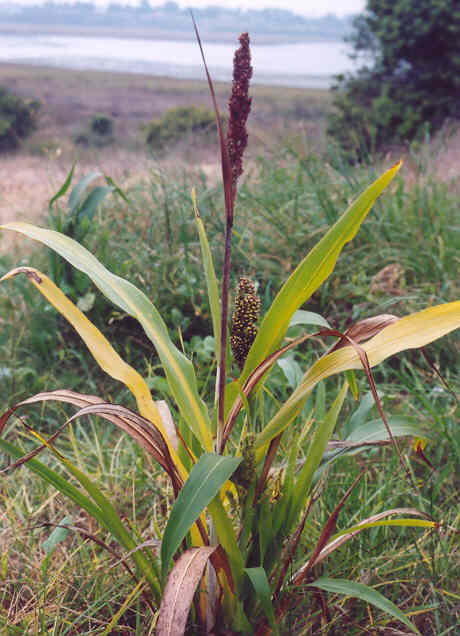
 |
Sorghum bicolor (L.) MoenchPoaceae (Grass Family)Africa SorghumSudan GrassMilo |
Plant Characteristics: Annual, stems erect, 1-2 m. tall; lf blade 3-10 cm. wide; infl. 1-4 dm., open to compact, branches +/- spreading to stiffly erect; spikelets in pairs, trios at branch tips, lower sessile, ovoid, 4-9 mm; lower glume leathery, shiny, glabrous to puberulent, enclosing upper glume, florets; florets 2, lower sterile, upper fertile; lemma 4-5 mm., awn 5-10 mm. or 0.
Habitat: Disturbed areas, roadsides, fallow fields below 600 m; northern coast, northern coast ranges, great central valley, central coast, southern coast, desert floristic provinces. Widely cultivated, native to Africa. (Hickman, Ed. 1296).
Name: Sorgho, the Italian name. Munz, Flora So. Calif. 1000). Latin, bi, meaning two and Latin, color, tint, hue. (Jaeger 36, 63). Referring to the colors of the inflorescence.
General: Rare in the study area having been found only once and this in the 23rd St. area just below where Constellation Dr. dead ends into the area. (my comment). Cultivated for food, forage and sugar. The leaves and stems resemble Indian corn, but the spikelets, similar to those of Johnson grass, are all borne in panicles at the tips of the stems. The sorghums are of great value as forage crops, particularly in warm, dry areas. Plant breeders are constantly producing new cultivars for special purposes. There are dwarf, uniform hybrid strains that can be harvested with a grain combine and tall, leafy forms, some with sweet juice, used for forage and silage. Types with waxy grains can be used to produce tapioca. (Pohl 188). About 20 species, tropical and subtropical areas. (Hickman, Ed. 1296).
Text Ref: Hickman, Ed. 1296; Munz, Flora So. Calif. 1000.
Photo Ref: Oct. 03 # 13,14,15.
Identity: by R. De Ruff, confirmed by John Johnson.
First Found: October 2003.
Computer Ref: Plant Data 545.
Have plant specimen.
Last edit. 8/14/04.
 |
October Photo